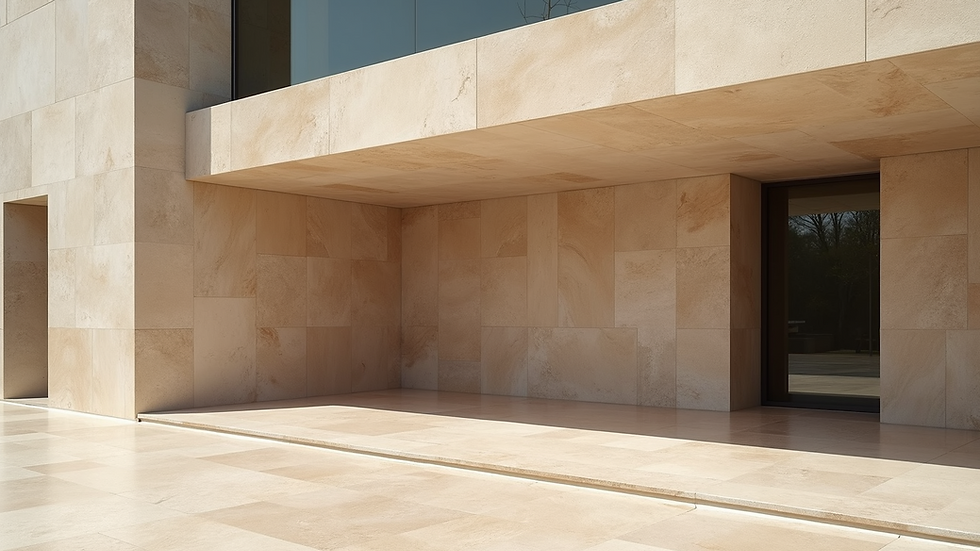The Timeless Elegance of Travertino Romano Exploring Its History, Present Innovations, and Future Potential
- Rettkrit Jaain
- Jun 16
- 3 min read
A Glimpse into the Beauty and Legacy of Travertino Romano
Travertino Romano, or Roman travertine, is not merely a stone; it embodies the timeless beauty and rich history of Italian architecture. Formed through natural mineral deposits, this remarkable material has captivated designers and architects for centuries. With stunning hues, intricate textures, and unique properties, travertine blends elegance and functionality. It's no wonder it continues to be a favorite choice in both modern design and classic architecture.
As we examine the rich history of this stone, its current applications, and what lies ahead, we uncover layers that reveal its lasting legacy.
The History of Travertino Romano
Travertine’s origins trace back thousands of years, prominently used in the infrastructure of the Roman Empire. Iconic structures like the Colosseum and ancient aqueducts showcase the stone’s enduring structural strength. Regions around Tivoli, known for significant volcanic activity, produced high-quality travertine that gained popularity due to its versatile uses.
This beautiful stone represented wealth and sophistication. Structures adorned with travertine became symbols of power, enhancing public buildings, temples, and monuments, establishing it as a key material in ancient Roman architecture. Today, walking through Rome, the presence of travertine echoes stories of art and culture over the centuries.
Travertino Romano in Contemporary Architecture
Currently, travertine is experiencing a renaissance in modern architecture. Designers embrace this classic material across various residential and commercial projects, from stylish facades to stunning interiors.
Variety is one of travertine's key strengths. It offers finishes like honed, polished, and tumbled, each creating distinct visual effects and practical benefits. For example:
Honed finish: Great for outdoor decks as it is less slippery.
Polished finish: Ideal for luxury interiors, reflecting light beautifully.
Contemporary examples of travertine in architecture include luxury hotels and hot new restaurants. Its adaptability allows it to enhance styles ranging from minimalist to elaborate, creating spaces that blend traditional elegance with modern flair.

Innovations in the Use of Travertine
Advancements in quarrying and finishing techniques are pushing the boundaries of travertine's uses. Today, sustainable extraction methods are emerging, focusing on eco-friendly practices. For instance, some quarries implement water recycling systems that reduce waste in the mining process.
Moreover, modern technologies like water jet cutting and innovative polishing methods enhance the precision and quality of travertine products. This allows architects to create intricate designs and patterns, adding unique aesthetics to their projects.
On top of this, the trend of incorporating natural materials into architecture is rising. Travertine’s earthy tones and organic textures complement biophilic design principles, which foster connections between indoor and outdoor spaces. As more designers prioritize sustainability, travertine's natural abundance positions it as an aligned choice.
The Future of Travertino Romano
Looking ahead, travertino romano's future appears promising. With an increasing emphasis on sustainable building materials, travertine is gaining attention for eco-conscious design.
There are exciting possibilities for unique applications. Designers are venturing beyond conventional flooring and wall coverings, exploring uses such as sculptural decorative pieces, outdoor installations, and furniture. Mixing travertine with other materials can create stunning, innovative results.
As urban areas expand, the demand for beautiful and sustainable landscaping materials will likely increase. Travertine’s durability makes it suitable for outdoor spaces, walkways, and patios, merging visual appeal with practical design in versatile applications.

Embracing the Legacy of Travertino Romano
Travertino Romano has evolved from its historical significance in ancient Rome to becoming a modern favorite among designers and architects. Its captivating appearance, durability, and eco-friendly features make it a vital component of contemporary architecture.
As design innovation and environmental awareness grow, the appreciation for travertine will likely continue to flourish. This beautiful stone, with roots in history, will remain a significant element in inspiring creative architectural beauty for years to come.
In recognizing both its historical value and promising future, we find that travertino romano is more than just a stone; it connects us to the past and shines as a promising choice for design. Whether gracing grand structures or intimate spaces, travertine resonates as a symbol of timeless elegance.


An insightful and beautifully articulated piece! The way you've traced the historical significance of Travertino Romano from ancient Roman architecture to its contemporary applications is truly commendable. I especially appreciated the exploration of sustainable innovations and how this timeless material continues to evolve without losing its classical charm. A compelling read for anyone passionate about design, history, or architectural materials.